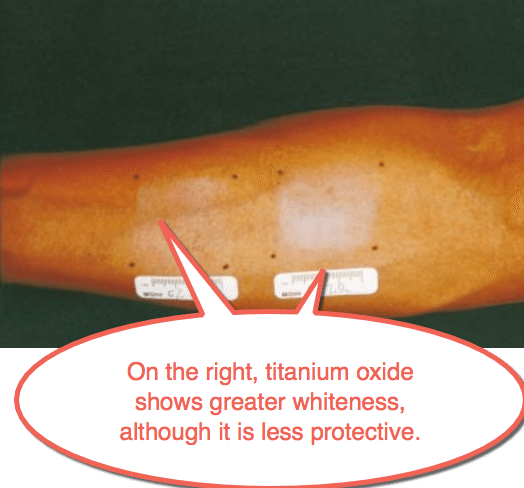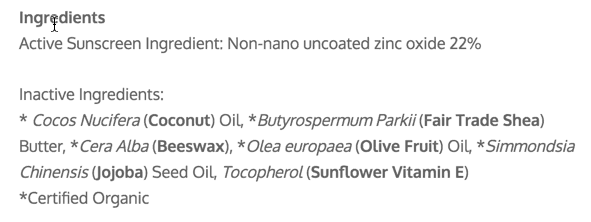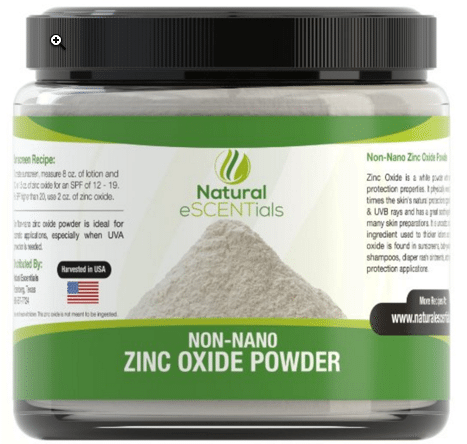
As we approach the sunnier months in the northern hemisphere, people start thinking about slathering on the sunscreen.
And there are more myths about sunscreen than anything else except for big Pharma, LOL.
Personally, I avoid sunscreen.
I wear a hat, and I expose myself to the sun as often as I can.
But the truth is, that some people do want sunscreen.
So I wanted to address sunscreen in this newsletter.
There are a number of ingredients that are relatively safe when spread on the skin, and that prevent sunburn.
But which is best?
 What you want is a product that is safe over a long period time.
What you want is a product that is safe over a long period time.
And you want a product that doesn’t penetrate the skin.
Ingredients such as zinc oxide and titanium dioxide are attractive because they remain on the skin’s surface, minimizing the problems of irritation and sensitization, and maximizing their safety profile.
Also, zinc oxide is less prone to show whiteness when you apply it.
So you won’t look like the abominable snowman when you apply it.
Here’s an illustration of that:
 And just to make sure it’s safe, many studies show its photostable, safe, and it absolutely works.
And just to make sure it’s safe, many studies show its photostable, safe, and it absolutely works.
 People use all kinds of sunblocks that have a lot of nasty ingredients in them.
People use all kinds of sunblocks that have a lot of nasty ingredients in them.
Perhaps the best ingredient you can use if you do want to use sunblock is zinc oxide.
It’s just plain powdered zinc oxide that you spread on your body.
Microfine zinc oxide is an effective and safe sunblock that provides broad-spectrum UV protection, including protection from long-wavelength UVA.
If you’re going to using oxide, try to use a sunblock that contains micro-fine, rather than nano-sized particles.
Many studies show nano-sized particles are probably safe.
But it’s best to use a larger particle size that is less likely to penetrate the skin.
Also, try to avoid a zinc oxide sunblock that contains a lot of bad ingredients.
You are going to be applying this to your body.
A lot of what’s in the sunblock will penetrate your skin, enter your body, and have to be metabolized.
You don’t want to put anything on your skin that you wouldn’t be willing to eat.
If you’re wondering what options are best, I have something.
I don’t have any connection with this company, but the products are in the right direction.
It’s called Butterbeanorganics.com.
 You can also buy plain non-nano zinc oxide and mix your own sunblock.
You can also buy plain non-nano zinc oxide and mix your own sunblock.
You mix it with a bit of coconut oil yourself.
 Whether or not it’s a good idea to use sunblock is a decision that you have to make.
Whether or not it’s a good idea to use sunblock is a decision that you have to make.
In another newsletter, I want to talk about the effects of the sun.
I’ll talk about how we should actually get a lot more sun exposure than we are getting.
I have information on how sun exposure prevents more cancer than it causes.
But that’s another newsletter.
Right now I want to give you an option for a sunscreen that is safe and should be useful for you over the summer months.
Citations
Microfine zinc oxide (Z-Cote) as a photostable UVA/UVB sunblock agent
http://www.jaad.org/article/S0190-9622(99)70532-3/fulltext?refuid=S0190-9622(10)00022-8&refissn=0190-9622
Microfine Zinc Oxide is a Superior Sunscreen Ingredient
to Microfine Titanium Dioxide
https://www.researchgate.net/profile/Nikiforos_Kollias/publication/12556241_Microfine_Zinc_Oxide_is_a_Superior_Sunscreen_Ingredient_to_Microfine_Titanium_Dioxide/links/02e7e52224a6eaa5ea000000.pdf
See this for more on Sunscreen, and see more on Anti-Aging, and for more information see effects of Sunscreen on body.
